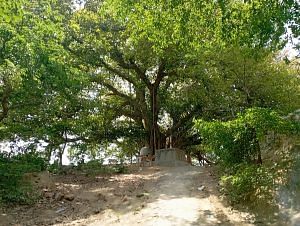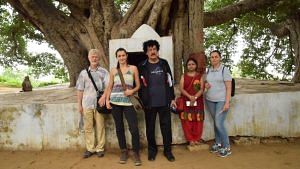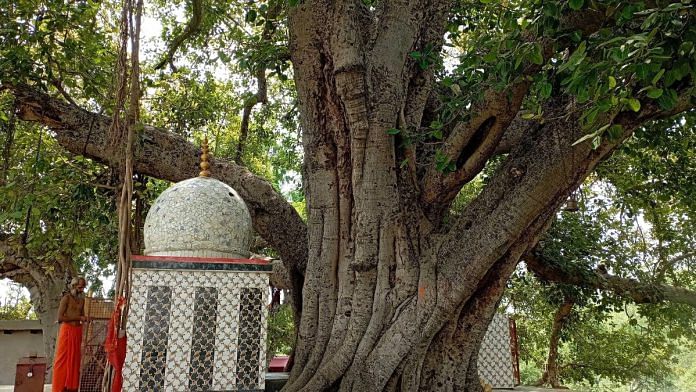Ramghat: A majestic banyan tree presides over a little ridge by the banks of the Ganga, just a few kilometres away from the smoking towers of the Narora Atomic Power plant in Uttar Pradesh. Priests and guardians of the tree say that the Siddhvari—as they call it—has existed for thousands of years, with its roots going back to the Mahabharata. But radiocarbon dating, recently undertaken by researchers from the Botanical Survey of India, or BSI, with a team from Romania, reveals that the tree is an estimated 400-500 years old.
The study, published in the latest edition of the journal Current Science may have disappointed the priests, but the Siddhvari is now the oldest banyan tree to have been scientifically dated in the world. Residents say that praying at the sacred grove where the tree lives takes away all their troubles and fulfils their wishes.
“Well, doesn’t sitting here itself make your heart more peaceful?” says Ashokanand, one of the priests who acts as a guardian of the tree.
With a canopy stretching over 4,069 square metres – making it the 10th largest banyan tree in the world – it is supported by two main trunks and four secondary roots. At its base, its circumference measures over 10 metres. It stands over 27 metres tall on a raised platform constructed at its base, on which miniature shrines to Hindu gods have been built. Sacred bells hang from its branches.

The grove is usually secluded, but rarely quiet. Hundreds of monkeys reside in its leafy branches, and feast on the offerings of those who come to pray at the spot. But even their chatter is drowned out by the chirping of crickets, which are active even during the day.
Also read:
Life around the tree
Over the last few years, Ashokanand has seen a growing interest in the tree. A few scientists and reporters have visited it, but the tree has never been quite a tourist attraction – like the 500-year-old Kantharpur banyan tree in Gujarat’s Gandhinagar or the 300-year-old banyan tree in Ajara district of Maharashtra’s Kolhapur.
“The villagers come here on amavasyas and poornimas to offer their prayers,” he says. “Sometimes, when they are going through difficulties in their lives, they come to it for solutions.”
Ashokanand wakes up every day at 4:30 am to clean and water the tree. This is followed by the morning prayers in a small temple placed right under the grove. He resides within the premises that have been built near the sacred grove, along with other priests. For residents, the tree is an integral part of their ordinary lives – so much so, that questions from curious scientists amuse them.
“We come to pray to the tree every fortnight. It is said to solve everyone’s problems. I don’t know how old it is; I have heard that it must be thousands of years old,” says local farmer Krishnadevi while working on her land just a few hundred metres from the tree.
Also read:
How researchers got involved
Arti Garg, a scientist with the BSI in Allahabad, identified the Siddhvari sacred grove during field surveys for the Ministry of Environment, Forests and Climate Change, Government of India project on ‘Floristic diversity of Upper Ganga Ramsar site in Uttar Pradesh’. BSI scientists conducted field surveys between 2012 and 2017 from Brij Ghat in UP’s Ghaziabad district to Narora in its Bulandshahr district.
The Siddhvari sacred grove stands on the edge of a ridge that marks the beginning of the forest land designated as a Ramsar site in 2005.
Garg collaborated with a research team from Romania, who have developed an innovative method to estimate the age of living trees without causing lasting damage to the tree trunk.

“Our research team began studying the age, growth and architecture of baobab species in 2005. It started with the African baobab, gradually expanding to other baobab species, continents and, finally, to large and/or old trees around the world,” Roxana Patrut, a researcher at Babeş-Bolyai University in România, tells ThePrint.
“We knew about the baobabs of Kintoor and Allahabad and reached out to Dr Arti Garg, who seemed to share our passion for trees. She proposed to expand our collaboration to some tree specimens that she identified during her botanical surveys and which she considered to be very old,” she adds.
For Patrut’s team, the sample collection – for which they visited India in 2018 – was a unique experience in itself. Thanks to the tree’s sacred status, sample collection requires not only the permission of the National Biodiversity Authority of India but also the consent of local guardians – who is, in this case, the priest.
“We had to perform a ritual and circle the tree seven times while praying for it to allow and forgive the investigation process,” Patrut tells ThePrint.
To carry out the study, researchers extracted a sample about 34 cm long from one of the main stems of the tree. The small coring hole was then shut with a special polymer sealing product to prevent infection.
Three tiny segments of wood – each about a millimetre long – were selected along the sample to undergo pretreatment and radiocarbon dating. The analysis revealed that the tree’s age was about 450 years, give or take 50 years.
This makes it the oldest banyan tree in the world to be radiocarbon dated.
However, it is not the oldest banyan tree in the world. Pillalamarri – a banyan tree in Telangana’s Mahbubnagar district – is considered the oldest, dating back to 800 years per historical records.
Also read: Indian companies want green-skilled professionals. But education system is yet to catch up
Threats to watch out for
The sacred status of the tree offers it a measure of protection from encroachers, but that’s not the only threat it faces. According to Patrut, the banyan should be monitored in the context of climate change for emerging pathogens, stress, etc.
“Monitoring can enable the implementation of timely preventative measures,” Patrut added.
The team is particularly concerned that the canopy is not growing unilaterally – which can affect the tree’s structural integrity in the coming years.
The team wrote in the study that the tree has an unusual architecture, in that it consists of two main units containing the primary stems covered by roots, and just four secondary prop roots. As a result, the canopy is disproportionately expanding in one direction – towards the Ganga.
“This unbalanced growth calls for implementing preventive protection measures to monitor and conserve this archaic botanical treasure,” the team wrote in their study.
For now, the tree’s fate remains in the hands of the local priests whose faith drives the motivation to conserve it – once again demonstrating that engaging local communities can help effectively preserve unknown and undiscovered ecological treasures.
(Edited by Zoya Bhatti)



